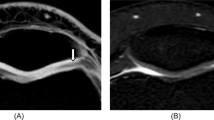Abstract
Aim of this study was to develop a time-efficient sequence protocol for a 1.0 T dedicated MR system to be used for whole-organ scoring of osteoarthritis (OA). Thirty-four knees were examined using a protocol that included fat suppressed fast spin echo proton density weighted sequences (PDFS) in three planes plus a coronal STIR sequence. Two radiologists scored each knee by consensus for five OA features. In separate sessions, all knees were scored using three different combinations of sequences: (1) all four sequences (reference protocol, 16 min 31 s scanning time), (2) three PDFS sequences without STIR (“No STIR”, 12 min 25 s scanning time) and (3) sagittal and axial PDFS sequences plus a coronal STIR sequence (“No PDFS”, 11 min 49 s scanning time). Agreement of the readings using both subsets of sequences compared to the reference protocol was evaluated using weighted kappa statistics. κ-coefficients showed good or excellent agreement for both sequence subsets in comparison to the reference protocol for all assessed features. κ-coefficients for No PDFS/No STIR: bone marrow abnormalities (0.74/0.67), subarticular cysts (0.84/0.63), marginal osteophytes (0.77/0.71), menisci (0.75/0.79), tibial cartilage (0.71/0.78). Optimization of sequence protocols consisting of three sequences results in time savings and cost efficiency in imaging of knee OA without loss of information over a more time consuming protocol.







Similar content being viewed by others
References
Peterfy CG (1998) Magnetic resonance imaging. In: Brandt KD, Doherty M, Lohmander S (eds) Osteoarthritis. Oxford University Press, New York, pp 473–494
Peterfy CG (2002) Imaging of the disease process. Curr Opin Rheumatol 14:590–596
Guermazi A, Zaim S, Taouli B, Miaux Y, Peterfy CG, Genant HK (2003) MR findings in knee osteoarthritis. Eur Radiol 13:1370–1386
Peterfy CG, Guermazi A, Zaim S, Tirman PFJ, Miaux Y, White D, Kothari M, Lu Y, Fye K, Zhao S, Genant HK (2004) Whole-Organ Magnetic Resonance Imaging Score (WORMS) of the knee in osteoarthritis. Osteoarthr Cartil 12:177–190
Masciocchi C, Barile A, Satragno L (2000) Musculoskeletal MRI: dedicated systems. Eur Radiol 10:250–255
Peterfy CG, Roberts T, Genant HK (1998) Dedicated extremity MR imaging: an emerging technology. Magn Reson Imaging Clin N Am 6:849–870
Pessis E, Drape JL, Ravaud P, Chevrot A, Dougados M, Ayral X (2003) Assessment of progression in knee osteoarthritis: results of a 1 year study comparing arthroscopy and MRI. Osteoarthr Cartil 11:361–369
Drape JL, Pessis E, Auleley GR, Chevrot A, Dougados M, Ayral X (1998) Quantitative MR imaging evaluation of chondropathy in osteoarthritic knees. Radiology 208:49–55
Bredella MA, Tirman PF, Peterfy CG, Zarlingo M, Feller JF, Bost FW, Belzer JP, Wischer TK, Genant HK (1999) Accuracy of T2-weighted fast spin-echo MR imaging with fat saturation in detecting cartilage defects in the knee: comparison with arthroscopy in 130 patients. Am J Roentgenol 172:1073–1080
Mohr A (2003) The value of water-excitation 3D FLASH and fat-saturated PDw TSE MR imaging for detecting and grading articular cartilage lesions of the knee. Skelet Radiol 32:396–402
Recht MP, Kramer J, Marcelis S, Pathria MN, Trudell D, Haghighi P, Sartoris DJ, Resnick D (1993) Abnormalities of articular cartilage in the knee: analysis of available MR techniques. Radiology 187:473–478
Brennan P, Silman A (1992) Statistical methods for assessing observer variability in clinical measures. BMJ 304:1491–1494
Wohlgemuth WA, Roemer FW, Bohndorf K (2002) Short tau inversion recovery and three-point Dixon water-fat separation sequences in acute traumatic bone fractures at open 0.35 Tesla MRI. Skelet Radiol 31:343–348
Delfaut EM, Beltran J, Johnson G, Rousseau J, Marchandise X, Cotten A (1999) Fat suppression in MR imaging: techniques and pitfalls. Radiographics 19:373–382
Mohr A, Roemer FW, Genant HK, Liess C (2003) Using fat-saturated proton density-weighted MR imaging to evaluate articular cartilage. Am J Roentgenol 181:280–281
Burgkart R, Glaser C, Hyhlik-Durr A, Englmeier KH, Reiser M, Eckstein F (2001) Magnetic resonance imaging-based assessment of cartilage loss in severe osteoarthritis: accuracy, precision, and diagnostic value. Arthritis Rheum 44:2072–2077
Acknowledgements
The Multicenter Osteoarthritis Study (MOST) is a 7-year cooperative epidemiological study of knee osteoarthritis funded by the National Institute on Aging (NIA) within the National Institutes of Health (NIH).
NIA grant numbers: U01 AG18820, U01 AG19069, U01 AG18832, U01 AG18947.
Author information
Authors and Affiliations
Corresponding author
Rights and permissions
About this article
Cite this article
Roemer, F.W., Guermazi, A., Lynch, J.A. et al. Short tau inversion recovery and proton density-weighted fat suppressed sequences for the evaluation of osteoarthritis of the knee with a 1.0 T dedicated extremity MRI: development of a time-efficient sequence protocol. Eur Radiol 15, 978–987 (2005). https://doi.org/10.1007/s00330-004-2608-6
Received:
Revised:
Accepted:
Published:
Issue Date:
DOI: https://doi.org/10.1007/s00330-004-2608-6




